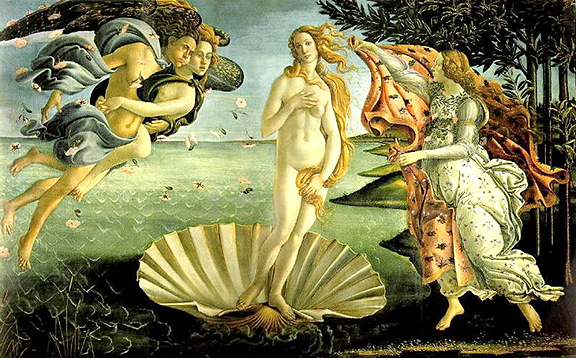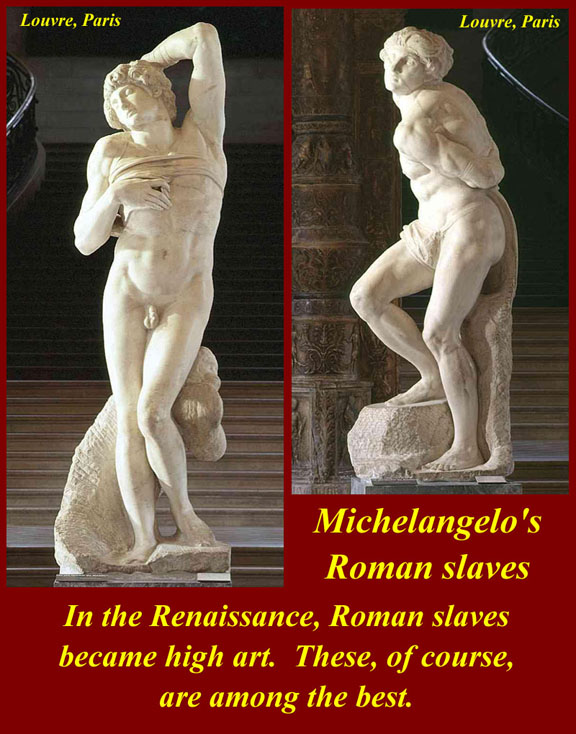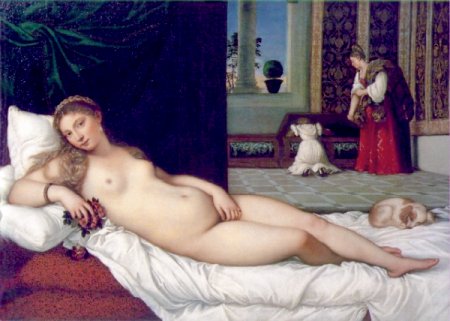

Posted on 11/24/2005 9:48:40 AM PST by Republicanprofessor
In this third “class” of this second Art Appreciation series, we’ll examine the various styles of the Renaissance. The Renaissance in Italy is the most varied and the most famous, but there is also a Renaissance in northern Europe, with the works of Bosch, Durer and Brueghel. (If you want to see the other lectures of this series to which I refer here, check on my name below to get to my homepage for clickable links to those very lectures.)
Renaissance means “rebirth” of classical Greek and Roman realism, grace, and dignity. If you remember back to lesson two of this series, the Early Christians abandoned realism as too pagan, and their work was very flat and thus spiritual. (See “lesson” two of this series.) But gradually over the next millennium, works became more and more rounded and realistic, especially with the Gothic work of Giotto, with whom we ended the last lecture. Giotto, under the probable influence of St. Francis, began looking and appreciating real life, drawing from live models. His work was done in 1305, and in 1348, the Black Plague struck Europe, killing about one third of the population. Many artists died, and those that didn’t often reverted back to older styles. Giotto’s work wasn’t re-appreciated until the turn of the next century: 1400.


Above we have images of Giotto’s Arena Chapel in Padua, including a wonderful image of Christ entering Jerusalem. Notice the little figure on the right stuck in his green garment which he wanted to take off to put at Jesus’ feet. What a wonderful human touch: but he will miss all the excitement. How many of us have gotten stuck in clothes pulled over our heads, although perhaps not at a moment as seminal as this one was.



Around 1420, Masaccio takes Giotto’s ideas of mass and shading (also called modeling) and adds a sense of real light. In this wonderful chapel, there is a real window in the center, and that light seems to illuminate this wonderful fresco. (Frescoes are painted directly into fresh plaster and bond with the plaster, so the paint is in the wall and not just on the wall. It is a tricky process, but it is very durable and common in Italy from the Gothic age onward.)
One of the best examples of what Masaccio has done is in the Adam and Eve image within this same chapel. On the right we have a teacher/colleague of his, Masolino, who has painted the Temptation in an elegant, non- agonized style, as if this temptation was held at a nudist cocktail party. Masaccio adds much more drama and pain to the complementary Expulsion; the bodies recoil in trauma. And the lines on the left seem to be God’s voice saying “Get Out!!” We will see soon how Michelangelo will be inspired by Masaccio, down to the same expelling angel flying overhead. Also famous is his Tribute Money, down to the figure of St. Peter on the left getting a coin from a fish’s mouth to pay the tax. Notice the realism of the bodies beneath the drapery and the symbolic half-circle the figures form, as well as the sense of real space behind them in the mountains.


.jpg)


Donatello, in sculpture, revived Roman values and heroism as Masaccio was doing in painting. His David from the 1430’s or so, is younger than what will follow in Michelangelo’s 1501 David. Donatello’s work is the first freestanding nude figure since antiquity, and it is standing in a full contrapposto pose, in one knee is realisitically bent, so that weight is shifted to one side so one can move effectively. Donatello also did some remarkably powerful saints, such as Zuccone (pumpkin head) above. His Gattamelata is the equestrian statue, inspired by the Roman one of Marcus Aurelius, and which will motivate so many equestrian statues to come.
There were many wonderful Italian lyrical works done in the quattrocento (a fancy way of saying the 1400s, or fifteenth century). I can show a few below, but I cannot begin to discuss them all. Fra Angelico painted a mural for each monk’s cell at San Marco in Florence; Ghirlandaio, teacher to Michelangelo, painted the birth of the Virgin with leading Florentine women in attendance. What beautiful architecture, so like the homes of the Strozzi, Medici and other families back then!


Botticelli moved away from realism toward more symbolism. Although the Birth of Venus is important, I prefer Primavera (Spring) for discussion of symbolism. Art historians have argued about the meanings behind this for ages, but I prefer the love and marriage interpretation. Some characters are in both paintings. Can you see them?


In Primavera, the second image, we see the March Wind Zephyr blowing in spring and abducting the nymph Chloris who, after a lustful seduction, becomes Flora, the Roman goddess of flowers. On the left, we see the representation of the Three Graces, platonic love (outlined with Botticelli’s wonderful sense of line and lyrical, transparent drapery). In the center stands Venus, a rather chaste version (since she is clothed). She may represent marital love, and may be a bride of one of the Medicis (that rich, art-loving family of Florence in the 15th century). On the far left, Mars clears away the clouds to stop the advance of Spring at May. He looks very much like one of the Medici and may be a portrait of the groom. Thus this painting unites allegories of spring and love and may have been hung, with Birth of Venus as a counterpart, in a Medici bedroom.
Let’s go to northern Europe for a moment and do a bit of comparison. We have an Italian fresco of the Resurrection on the left in the second row, by Piero della Francesca, and three northern pieces: The Arnolfini Wedding Portrait signed by van Eyck, the Deposition by van der Weyden and the Isenheim altarpiece inside and outside, by Grunewald.





So, what differences do you see? Look at the drapery and folds therein: which shows the body and which covers the body and emphasizes the exterior instead? Which has richer color? The use of oil paint, with its translucent layers, was developed originally in Flanders (roughly Holland today) and allows for much deeper color than Italian fresco. What about details? Much of what you see in the wedding portrait is symbolic of fertility. (No, this is not a shot-gun marriage; she is not pregnant. But she is longing to be so, and that is why so much symbolism deals with fertility. The sad thing is that they never did have children.) The scene is beside a red bed, the little broom in the back shows her virginity, the single candle shows that the marriage has not yet been consummated. Even the mirror is important: it shows not only the reflection of the whole scene, but has the passion of Christ illustrated around it.
Notice also the compositional contrast between the two right works: Piero designs around a triangle (symbolic of the Trinity), while van der Weyden has slumped figures of Christ and the fainted Mary echoing each other. There is much more emotion and outward grief in the Flemish work; Piero is much more restrained. Note the pain, details, bright colors and symbolism also within Grunewald’s altarpiece. The Resurrection on the right is almost the complete opposite of Piero’s vision. (By the way, a great trivia note here: how many legs are on the soldiers in Piero’s work? Four legs, for four soldiers? He is so interested in an almost abstract simplification, that we don’t even notice the lack of clutter from what would have been the proper number of legs.)
Back to Italy, for the High Renaissance, from roughly 1495-1525, was quite short-lived. At this point the dignity, grace and realism reach a wonderful peak. We have the scientist and engineer Leonardo da Vinci creating wonderful works with great contrasts of light and dark (chiaroscuro) and a smokey atmosphere (sfumato). We all know of his Last Supper and Mona Lisa. My favorite is the Virgin, Child and St. Anne below. Here Mary sits on her mother’s lap (although they look awfully similar in age to me.) Christ plays with a lamb, as in a petting zoo, but his mother tenderly pulls him back from the symbol of his sacrifice. Those circles of arms seem to me to be a chain of love. In the background, we see Leonardo’s typical primeval rocks, as if the earth is being formed anew with the New Testament.





Raphael painted the quintessential images of Madonna and child in balanced round or pyramidal compositions of sweet, harmonious colors and grace. He also painted several series of frescoes in the papal apartments, most notably the School of Athens 1510-12. Plato (actually a portrait of Leonardo) on the left walks with Aristotle on the right down the aisle of what could be the new architecture of St. Peter’s. On the right are all the followers of Aristotle, including Euclid (a portrait of the Renaissance architect Bramante) and others. On the left, we see the neoplatonic philosophers, including Michelangelo slumped by himself in the front. This image was added after Raphael had seen some of the Sistine Chapel.




Michelangelo’s Sistine Chapel contains some of the most marvelous images of the creation of the world and of Adam and Eve. I cannot even begin to do justice here to this most incredible of paintings. We do all know of the Creation of Adam. However, one recent theory is that because God is in a form that resembles a brain, perhaps God is giving Adam not life but intelligence. It is the Temptation and Expulsion that I love best. Note how muscular Eve is. Michelangelo (and most other artists) were not allowed to paint from nude females; so they use male models and then added breasts. This explains her hardened, muscular body: from her rearend to her biceps. I like the way Adam reaches sinfully as much as Eve does. Note too that she is quite close to “intimate carnal knowledge” of Adam (a Monica Lewinsky pose?). But here she is still innocent and beautiful. Not so with the Expulsion, so inspired by Masaccio above. Note how their bent bodies also convey their wracked emotions.



Michelangelo was a master of the human body and of expression through pose. The slaves he created for the (doomed and never-finished-as-envisioned) tomb of Julius II show the amazing tension of a soul trapped in a physical, tempted body (a neoplatonic idea I cannot adequately develop here). He also did incredible images of a most loving and human Madonna: especially the Bruges Madonna. He also has many images of the Christ child nursing. What struck me recently was how much that may represent the experience or the longing of his childhood. After birth, he was sent to a wet nurse who was the wife of a quarry owner. Michelangelo always thought that the stone of the quarry somehow got into him and made him a sculptor. I also wonder if the great love and coziness of his madonnas do not also reflect that time at the wet nurse’s or his desire to have spent that time with his mother. (I know very little about his mother, although he lived in his father’s house in Florence for much of his life, when he wasn’t working in Rome on the orders of the pope then in power.)
Onward to the Venetians. The Renaissance in Venice reflected the more sensual and light-filled quality of that city. Venetian artists were some of the first Italians to use the rich oil paint from Flanders, so their color is wonderful. Bellini was the first great Venetian artist, and his St. Francis in Ecstasy shows a very spiritually inspired saint in the beautiful, glowing late afternoon light of a landscape filled with the animals who meant so much to him.



Giorgione is the first artist to have indefinite subject matter. Two of his pieces are above. Pastoral Symphony shows two men with two muses, one of whom refills the pitcher with water of inspiration. It is set in a dreamily beautiful landscape, and these men (one richer than the other) create music while the poetic symbol of a shepherd wanders in the background. The light in the sky is typical of Venetian works. In the Tempest, we have a storm and a nude woman nursing a baby with a soldier to the left. There is no such event in mythological or biblical history. I think it is about creativity, from the finished and unfinished architectural background to the creation and care for a child in the foreground. The lightening, to me, represents that very spark of creativity and imagination. This is another work that is much debated by art historians.
Giorgione died very young in the plague, and Titian took over. He actually finished or reworked some of his teacher’s paintings, but all to a great result. His most famous works are below.



Titian is famous for his luscious, golden nudes and sensuality. Again, the background has a stunning light (if not a fully developed landscape). The mistress on the left awaits her maids, who get her clothes from the trunk in the back. The faithful dog lies on the corner of her bed. Note the echoing of red and white from foreground to background, the careful balancing of space near and far. In his Bacchanal paintings, Titian showed the gods celebrating and feasting in the gorgeous landscape. They indulge in wine, with sensuous women reclining in the corner. Manet updates both these works in his Olympia and Dejeuner from the 1860s. (See my very first lecture on realism for more about these paintings.) Titian also did a great many altarpieces with the Madonna and Child, also filled with beautiful colors and figures.


The last episode of Renaissance art is a reaction to the beauty, realism and restraint of that art. Imagine being an artist coming of age in the 1520s: the masters have already created all the masterful, dignified and graceful works imaginable. So, one can either copy them insipidly or create entirely different works. Pontormo, Bronzino and Parmigianino did just that. Look at these works: notice their imbalanced composition (often with only hands circling in the middle). Where are the figures, inside or outside? Do we see a cross from which Christ is descending? Could any of these figures actually support Christ? Have you ever seen such a large, ugly, and dead Christ child? What different and clashing colors we see! And what an incestuous relationship in the last one between mother Venus and child Cupid!
/Pontormo%20-%20Deposition.jpg)


Mannerist architecture, such as that by Romano at the Palazzo Te in Mantua, is even more outrageous and wonderful, but since I haven’t even had time to discuss the architecture of Brunelleschi and Bramante, it is time to draw this “class” to a close. It is a bit frustrating to only mention some of the great works of the time, but perhaps we can embellish these ideas in the discussion that follows.
Now this all passes the sofa test (I need to get a bigger sofa though). No time to study in depth now however, Thank you.
Yes, especially for the Sistine Chapel. I don't think they even have sofas in there, although for the papal enclaves they do have beds (!).
1. That unbelievable, eye-watering, jaw-dropping art (well before the famous, or infamous if you prefer, restoration)
2. Lots of nuns
3. A fair number of overweight men in Hawaiian T-shirts and Bermuda shorts
What a hoot! (I couldn't believe I'd allowed myself to waste the whole morning trudging through all the Etruscan crap in the Vatican Museum)
This topic was posted , thanks Republicanprofessor.
Disclaimer: Opinions posted on Free Republic are those of the individual posters and do not necessarily represent the opinion of Free Republic or its management. All materials posted herein are protected by copyright law and the exemption for fair use of copyrighted works.